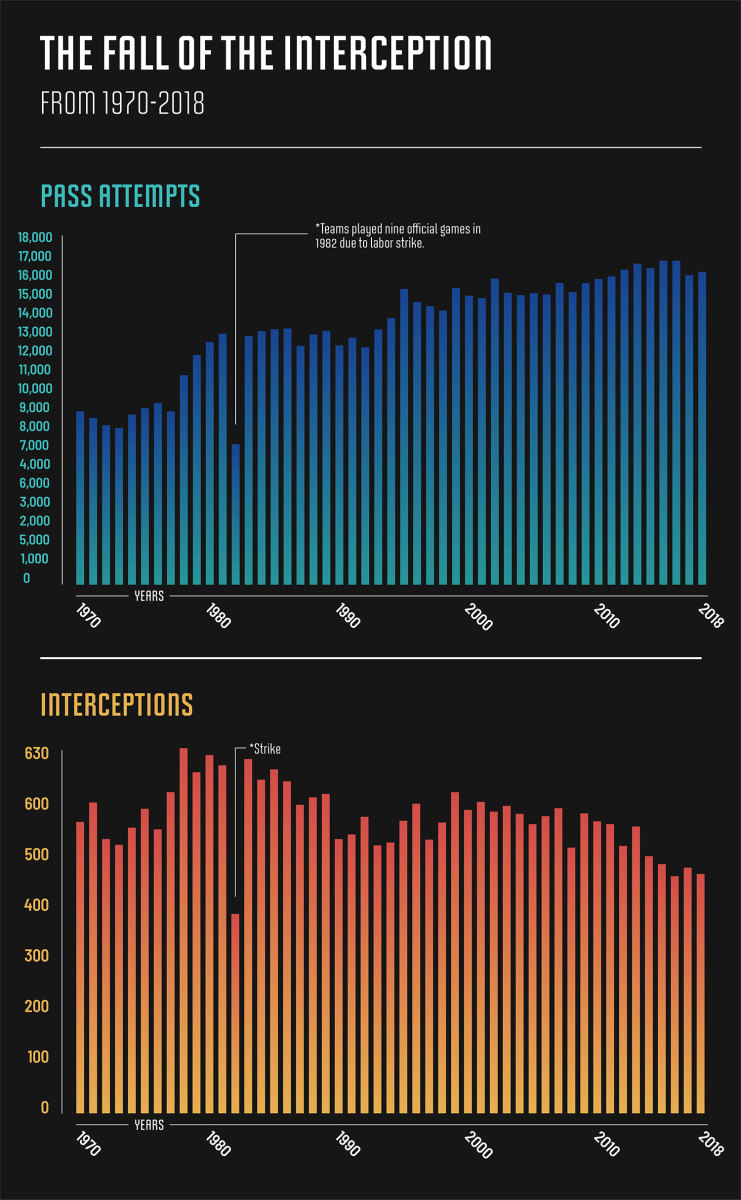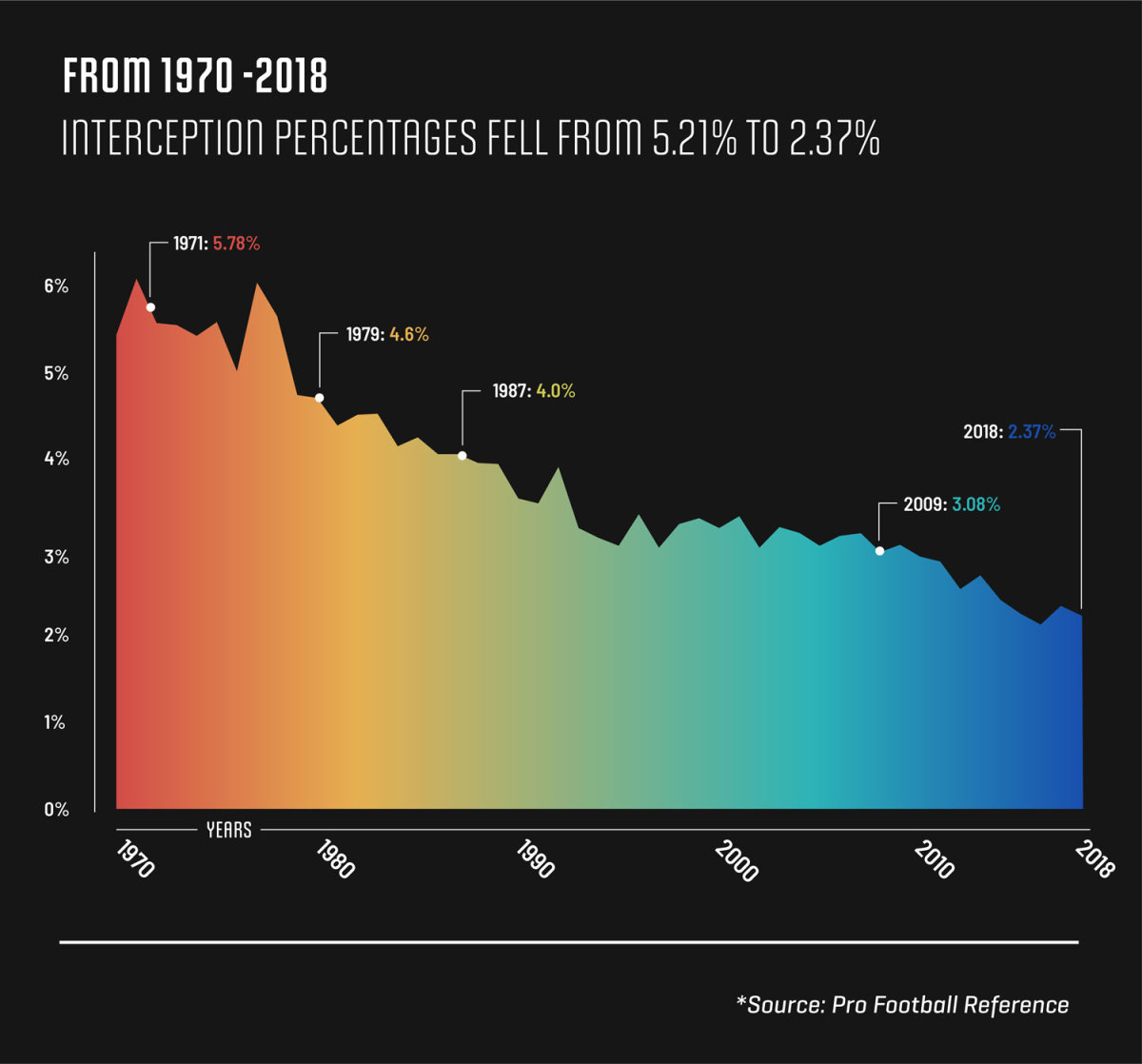The Declining Interception Rate in the NFL

Pro Football Hall of Famer Paul Krause hasn’t played since the 1979 season, but he still goes to every Vikings home game and keeps in touch with the players and coaches. The 77-year-old former safety holds the league’s all-time interceptions record with 81 in his career, and he recalls one time when Vikings coach Mike Zimmer approached him and asked, “How do I find another you?”
Krause says he didn’t know how to truthfully, or humbly, answer it. You don’t find another Paul Krause, right?
“Well… basically, yeah,” Krause says. “The game’s been going 100 years and nobody else has done it.”
Of all the great NFL records, sneakily the most unattainable is the interceptions crown. Rod Woodson played 17 years and still came up 11 picks short of topping Krause. Charles Woodson, who has 65 career interceptions, would have had to duplicate his two best seasons and tack those on to his 18-year career to beat out Krause. Aqib Talib, the 12-year corner for the Rams, is the NFL’s active leader in interceptions—with 35 career picks, he’s tied for 128th on the all-time list.
It’d be foolish to say defensive players today are less adept at catching the ball, of course. And with the ball being thrown more than ever before in the game, simple arithmetic would seemingly indicate a higher opportunity to get interceptions.

But the intercepted pass is disappearing from the NFL. The league’s interception rate (the percentage of pass attempts that are intercepted) has been below 2.5% in each of the past four seasons, and through only three weeks of the 2019 season we’re on pace for the all-time low of 2.17%. It was just above the 3% mark as recently as 2009, and the post-merger all-time high is 5.78% from 1971.
So where did the interception go? It appears there’s no single answer but the cumulation of rules changes, skills honed and schemes perfected over the decades.
***
Since the AFL and NFL joined forces in 1970, there has been a gradual, nearly linear decline in the league’s interception rate. Each decade since the merger has seen a drop in a full percentage point, more or less. If things continue, we’ll see a season with a rate of less than 2% in the 2020s.
But there is no drop on the chart bigger than the 1978 season to ’79, when the rate relatively plummeted from 5.4% to 4.6%.

What happened? In 1978, the NFL made major rules changes that helped offenses. The league prohibited intentional defensive contact with receivers within the first five yards, and it also allowed offensive linemen to pass block by using extended arms and open hands—a move that instantly protected quarterbacks and receivers. (Keep in mind that the rules were put into place before the 1978 season, so it’s not illogical to think it took a season for players and coaches to fully take advantage of the rules, thus explaining the drop in the interception rate a year later.)
“I think that’s the most significant rules changes in NFL history and clearly opened up the passing game,” says Chris Brown, who has written multiple books on football history and concepts. “Terry Bradshaw was winning the Super Bowl throwing 25 interceptions and the (1979) Steelers won the Super Bowl with 52 turnovers in a season. The Patriots won a couple years ago and had 11 in a season.”
Interceptions were such a part of the game that they outnumbered touchdowns through the 1982 strike year, though it’s happened only twice (’85 and ’92) since then. Into the 1980s the interception rate hovered around 4.5%, and as changes occurred around the league there were still plenty of ballhawks on the field.
A team that had those in spades were the 1985 Seahawks. When safety Eugene Robinson joined Seattle that year as a rookie, he teamed up with defensive backs Kenny Easley, John Harris, Dave Brown, Terry Taylor and Keith Butler. Brown, 10th in league history with 62 picks, took Robinson under his wing and taught him the importance of familiarizing his fingertips with the ball, so Robinson took to catching 100 balls before or after each practice. Harris, tied for 35th with 50 picks, taught Robinson the academic side of the game, that the three-step, five-step and seven-step drops all meant something different in the passing game.
Robinson finished his 16-season career with 57 interceptions, tied for 13th most in NFL history. He had at least one pick in every season he played.
“I would make it a point to be over there because guess what, what happens if they tip the ball because the corner’s in great position? That happens all the time,” Robinson says of his ball-tracking. “I’m going over there to look for the tip as I secure the tackle just in case things for awry. I wonder if people think that way. Or if they think I better not hit him because if I do I’m going to get flagged. I don’t know. I know what it was for us.
“You’ve got to put in the element on how the rules have changed on hitting a guy. You can’t do what we did back in the day to dislodge the ball and create interceptions. That ain’t going to happen or you’re going to get thrown out of the game.”
***
Dick Night Train Lane set the NFL’s single-season interceptions record in 1952 with 14 as a rookie and that season, in the 12-team NFL, 7.38% of all passes were intercepted. No NFL player has gotten into double digits since Antonio Cromartie had 10 in 2007 with the Chargers.
No one should think defensive backs nowadays want the ball less than any other time in NFL history. But are the quarterbacks now better than they used to be?
“I think that’s a tall order,” Robinson says. “I don’t think there’s any way you would win the argument.”
Perhaps. Or perhaps quarterbacks today are more skilled throwers than those of yesteryear—young quarterbacks go through endless 7-on-7 camps and hire quarterback coaches if you have enough money.
But Talib gets to the heart of the matter.
“The schemes and stuff are more detailed. It’s elevated,” Talib says. “Back when he had 81 picks, guys were probably running fades and slants. There was probably one receiver in his three-point stance. The receivers are bigger and faster and the quarterbacks, the game is getting way more detailed. We have to be that much sharper.”
The three-point stance is an exaggeration, but it’s inarguable that the passing-game concepts are far more precise today than ever before. The average yards per completion have decreased in the modern era, though not as steadily as the interception rate. Offenses have replaced handoffs with screen passes. The first-down run has turned into a quick hitch on first-and-10. There are quick throws to the flat and RPOs where “you’re throwing only high percentage short passes so not even if it’s not a successful play it’s probably not an interception,” Brown says.
“You went from Sid Luckman and those guys throwing bombs to Terry Bradshaw throwing downfield to Bill Walsh and Joe Montana doing three-step drops throwing slant routes,” he continues. “And you see that trend continue year after year.”
And so it seems the NFL, as currently constructed, will continue to erase the interception. But it’s still a debate topic among the best pick artists in the league today.
In the Rams locker room following their Week 1 win against Carolina, Talib and fellow cornerback Marcus Peters, who has the most interceptions in the league since 2015 (now at 23 after a pick-six in Week 4), got into a spirited debate about whether the latter could ever catch Krause’s record.
“It’s impossible!,” Talib shouted.
“No, no, no,” Peters replied. “You trippin, bro. I got 22 right now.”
“Yeah, you in Year 5,” Talib says. “Listen…”
“I’m on pace to do 60!,” Peters interjects.
“Then you’re 21 off 81!,” Talib exclaims.
Krause, meanwhile, sits comfortably with his unattainable record.
“Oh yeah, I’ve thought about it,” he says. “I’m not losing any sleep over it.”
Question or comment? Email us at talkback@themmqb.com.
